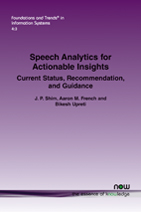Speech Analytics for Actionable Insights: Current Status, Recommendation, and Guidance
By J. P. Shim, Department of Computer Information Systems, J. Mack Robinson College of Business, Georgia State University, USA, jpshim@gsu.edu | Aaron M. French, Anderson School of Management, The University of New Mexico, USA, afrench@unm.edu | Bikesh Upreti, Department of Information and Service Economy, Aalto University School of Economics, Finland, bikesh.upreti@aalto.fi
Abstract
In today’s hypercompetitive customer-centric marketplace, every enterprise strives to gain competitive advantage through customer loyalty, high customer satisfaction and low customer turnover. Through the use of a combination of tools such as analytic technologies, and data-mining techniques and access to real-time data, companies are now able to place a greater emphasis on customer engagement and satisfaction. Today’s increased enforcement of standards and stricter legal compliance rules have led call centers to take proactive steps to ensure that enforcement is in compliance with regulations through the use of speech analytics. In the realm of analytic technologies, speech analytics is quickly becoming one of the most demanded technologies in customer engagement optimization and the fastest growing technology in call centers. Organizations have been searching for ways to translate this wealth of information into holistic, accurate, and actionable insights. The nascent technology is increasingly in more demand as its features become more relevant for call centers, and as organizations seek to capture the voice of the customer (VoC), or the customers’ wants and needs, and improve first call resolution (FCR) through post-call and real-time solutions. Speech analytics is a complementary approach for organizations driving optimization, personalization and targeting across their digital channels. Since the latest real-time voice/speech analytics technology can mine 100% of the company’s voice contacts, organizations can now be much more successful in capturing and tagging the reasons for the customers’ call. Given today’s ubiquitous computing trends, such as mobile voice and digital data stream, post-call and real-time applications are solutions to capture the voice of the customer, and improve operations and efficiency, customer experiences, and improve customer loyalty.
Speech Analytics for Actionable Insights: Current Status, Recommendation, and Guidance
Speech analytics utilizes speech recognition, predictive analytics, and authentication of the data streams while assessing customers' complaints in real-time. Assessment occurs through the collection and analysis of current data mixed with historical facts to determine patterns and to predict trends. In the current research, the authors have chosen to focus primarily on speech analytics, serving as an umbrella term encompassing speech analytics, audio-mining technologies. The use of speech analytics typically refers to a broader range of speech products, such as analyzing voice identification, emotion detection, and phonetics/speech analysis.
Speech Analytics for Actionable Insights proceeds with the discussion of an overview of enterprise needs for speech analytics, a brief history of the speech recognition, the infrastructure of phonetic versus transcription approaches and real-time versus post-call solutions, major speech analytics vendors and their features, applications found within case studies, and recommendations and guidance. The primary goal of this monograph is to help business decision-makers educate themselves on the burgeoning field of speech analytics as well as to understand how it impacts the broader enterprise landscape.
